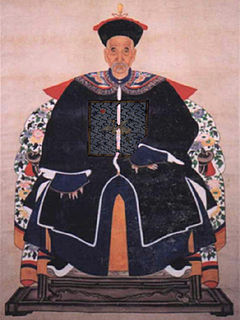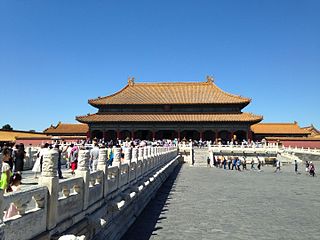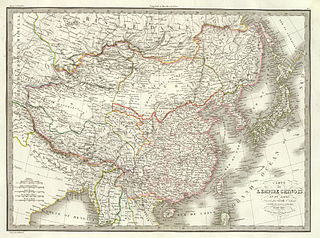
The Qing dynasty, officially the Great Qing, was a Manchu-led conquest dynasty and the last imperial dynasty of China. It was emerged from the Khanate of Later Jin (1616–1636), founded by the Jianzhou Jurchens who unified other Jurchen tribes to form a new ethnic identity as "Manchus", and proclaimed in 1636 as an empire in Manchuria. The Qing dynasty seized control over Beijing in 1644, then later expanded its rule over the whole of China proper and parts of Taiwan, and finally expanded into Inner Asia. The dynasty lasted until 1912 when it was overthrown in the Xinhai Revolution. In orthodox Chinese historiography, the Qing dynasty was preceded by the Ming dynasty and succeeded by the Republic of China. The multiethnic Qing empire lasted for almost three centuries and assembled the territorial base for modern China. It was the largest imperial dynasty in the history of China and in 1790 the fourth-largest empire in world history in terms of territorial size. With 419,264,000 citizens in 1907, it was the world's most populous country at the time.

The Ming dynasty, officially the Great Ming, was an imperial dynasty of China, ruling from 1368 to 1644 following the collapse of the Mongol-led Yuan dynasty. The Ming dynasty was the last orthodox dynasty of China ruled by the Han people, the majority ethnic group in China. Although the primary capital of Beijing fell in 1644 to a rebellion led by Li Zicheng, numerous rump regimes ruled by remnants of the Ming imperial family—collectively called the Southern Ming—survived until 1662.

Huangdi, translated into English as Emperor, was the superlative title held by monarchs of China who ruled various imperial regimes in Chinese history. In traditional Chinese political theory, the emperor was considered the Son of Heaven and the autocrat of all under Heaven. Under the Han dynasty, Confucianism replaced Legalism as the official political theory and succession in most cases theoretically followed agnatic primogeniture. The lineage of emperors descended from a paternal family line constituted a dynasty.

The Kangxi Emperor (康熙帝)(Xuanye; 4 May 1654 – 20 December 1722) was the third emperor of the Qing dynasty, and the second Qing emperor to rule over China proper, reigning from 1661 to 1722.

The Shunzhi Emperor was the second emperor of the Qing dynasty of China, and the first Qing emperor to rule over China proper, reigning from 1644 to 1661. A committee of Manchu princes chose him to succeed his father, Hong Taiji (1592–1643), in September 1643, when he was five years old. The princes also appointed two co-regents: Dorgon (1612–1650), the 14th son of the Qing dynasty's founder Nurhaci (1559–1626), and Jirgalang (1599–1655), one of Nurhaci's nephews, both of whom were members of the Qing imperial clan.

The Yongzheng Emperor was the fourth Emperor of the Qing dynasty, and the third Qing emperor to rule over China proper. He reigned from 1722 to 1735. A hard-working ruler, the Yongzheng Emperor's main goal was to create an effective government at minimal expense. Like his father, the Kangxi Emperor, the Yongzheng Emperor used military force to preserve the dynasty's position.

The Gujin Tushu Jicheng, also known as the Imperial Encyclopaedia, is a vast encyclopedic work written in China during the reigns of the Qing dynasty emperors Kangxi and Yongzheng. It was begun in 1700 and completed in 1725. The work was headed and compiled mainly by scholar Chen Menglei (陳夢雷). Later on Jiang Tingxi helped work on it as well.

Zhang Tingyu was a Han Chinese politician and historian who lived in the Qing dynasty.

In the now-abolished Chinese monarchy, various methods had been used to determine succession to the Chinese throne. The Mongol-led Yuan dynasty practiced blood tanistry, or competition among brothers, while the Ming dynasty favored primogeniture, with an emperor succeeded by his eldest son. During the Manchu-led Qing dynasty, an emperor would write an edict to select one of his sons in secret. An emperor could have numerous sons by women of various ranks, so the heir might not be obvious until it was announced.

The Ming dynasty, officially the Great Ming, founded by the peasant rebel leader Zhu Yuanzhang, known as the Hongwu Emperor, was an imperial dynasty of China. It was the successor to the Yuan dynasty and the predecessor of the short-lived Shun dynasty, which was in turn succeeded by the Qing dynasty. At its height, the Ming dynasty had a population of 160 million people, while some assert the population could actually have been as large as 200 million.
The Deliberative Council of Princes and Ministers, also known as the Council of Princes and High Officials and Assembly of Princes and High Officials, or simply as the Deliberative Council, was an advisory body for the emperors of the early Qing dynasty (1636–1912). Derived from informal deliberative groups created by Nurhaci (1559–1626) in the 1610s and early 1620s, the Council was formally established by his son and successor Hong Taiji (1592–1643) in 1626 and expanded in 1637. Staffed mainly by Manchu dignitaries, this aristocratic institution served as the chief source of advice on military matters for Hong Taiji and the Shunzhi and Kangxi emperors. It was particularly powerful during the regencies of Dorgon (1643–1650) and Oboi (1661–1669), who used it to enhance their personal influence.
The history of the Qing dynasty began in 1636, when Manchu chieftain Hong Taiji founded the dynasty, and lasted until 1912, when Emperor Puyi abdicated the throne in response to the Xinhai Revolution. The final imperial dynasty in China, the Qing dynasty reached heights of power unlike any of the Chinese dynasties which preceded it, engaging in large-scale territorial expansion. However, the Qing dynasty's inability to successfully counter Western and Japanese imperialism ultimately led to its downfall, and the instability which emerged in China during the final years of the dynasty ultimately paved the way for the Warlord Era.
In 1670, when the Kangxi Emperor of China's Qing dynasty was sixteen years old, he issued the Sacred Edict, consisting of sixteen maxims, each seven characters long, to instruct the average citizen in the basic principles of Confucian orthodoxy. They were to be publicly posted in every town and village, then read aloud two times each month. Since they were written in terse formal classical Chinese, a local scholar was required to explicate them using the local dialect of the spoken language. This practice continued into the 20th century.
A memorial to the throne was an official communication to the Emperor of China. They were generally careful essays in Classical Chinese and their presentation was a formal affair directed by government officials. Submission of a memorial was a right theoretically available to everyone from the Crown Prince to a common farmer, but the court secretaries would read them aloud to the emperor and exercised considerable control over what was considered worthy of his time. They were used in imperial China as a means of regulating corrupt local officials who might otherwise have escaped oversight.

The High Qing era refers to the golden age between 1683 and 1799 during the Qing dynasty of China during which the empire's prosperity grew to new heights. Set after the rule of the Ming dynasty, the High Qing saw China transformed into a commercial state with nearly twice the population of its predecessor, due to high political stability. Improvements in literacy also took place during this period, and China's territory greatly expanded north and west compared to the previous smaller Ming dynasty.
Events from the year 1670 in China.
Events from the year 1672 in China.
Events from the year 1683 in China.
Events from the year 1686 in China.













